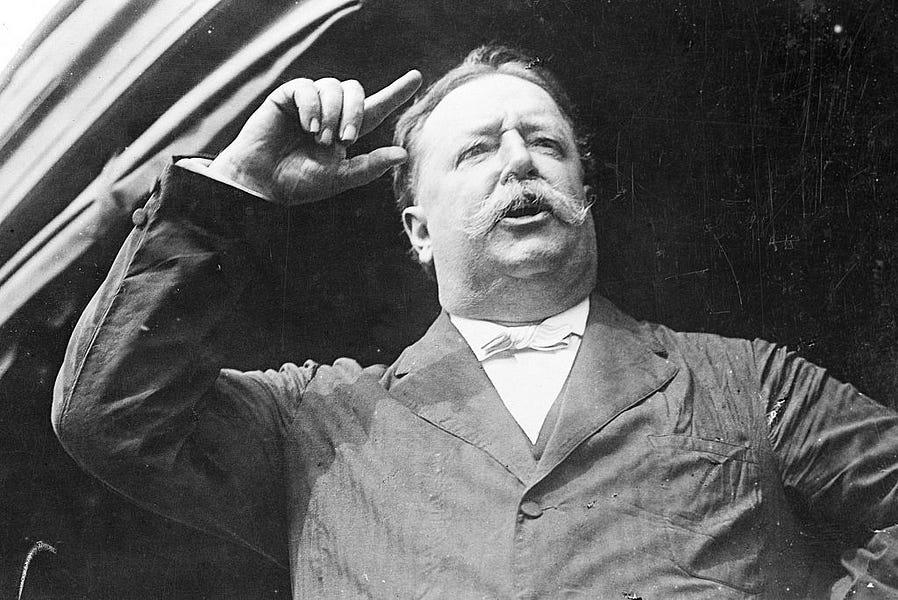On August 15, 1911, President William Howard Taft rejected Joint Resolution No. 14, which presented for his approval the formal recognition of Arizona and New Mexico as newly formed states. The addition of two new states was certain to be a notable event for his administration, but the president was hesitant. Both of the prospective states had submitted their constitutions for approval, and while Taft quickly blessed New Mexico’s governing document, Arizona’s constitution worried the future chief justice. The Arizona constitution included a radical form of judicial recall, one that was extreme even by the progressive politics of the day.
Judicial recall describes the process by which a judge may be subject to removal from office based purely on the public’s dissatisfaction with his performance, untethered to any accusation of official misconduct or crime. Together with the initiative and the referendum, judicial recall formed a three-pronged push for increased elements of direct democracy in American institutions. This drive to circumvent institutional safeguards unsettled President Taft, who would soon find himself openly at odds with the populist demagoguery of former President Theodore Roosevelt. Taft was a progressive in the parlance of the day, but he was no radical. He was above all a constitutionalist and a judge of the highest order. A lover of law and order, Taft believed the American constitution with its separation of powers and checks and balances represented the best available system to secure individual liberty and justice for all. Judicial recall struck at the very heart of Taft’s worldview.
Taft recognized that a key element of the American system was the independent judiciary, separate and apart from the legislative and executive branches, the so-called political branches of government. The undeniable purpose and effect of judicial recall was the complete subordination of the courts to the same popular will that controlled the political branches. In order to sit as the neutral arbiter of justice, courts needed separation from such popular domination and influence. Taft understood that removing this separation meant that the judiciary would be subject to majority domination in the day-to-day business of justice. Asked to approve a state constitution at odds with such a fundamental element of the American system, Taft balked. He rejected the Arizona constitution and explained his reasoning in a 10-page special message to the House of Representatives.
Taft was explicit in his disapproval. He declared, “This provision … in its application to county and state judges, seems to me so pernicious in its effect, so destructive of independence in the judiciary, so likely to subject the rights of the individual to the possible tyranny of a popular majority, and therefore, to be so injurious to the cause of free government, that I must disapprove a constitution containing it.”
Writing with a president’s hand but a judge’s mind, Taft went further:
[All] have recognized that the majority of a people, unrestrained by law, when aroused and without the sobering effect of deliberation and discussion, may do injustice to the minority or to the individual when the selfish interest of the majority prompts. Hence arises the necessity for a constitution by which the will of the majority shall be permitted to guide the course of the government only under controlling checks that experience has shown to be necessary to secure for the minority its share of the benefit to the whole people that a popular government is established to bestow.
Taft understood that a judiciary that must actively placate the furious demands of the majority must naturally bend under the pressure, with the result that its rulings reflect the will of the majority and not the true and sober application of the law. Taft explained, “A popular government is not a government of a majority, by a majority, for a majority of the people. It is a government of the whole people, by a majority of the whole people under such rules and checks as will secure a wise, just, and beneficent government for all the people.”
It is clear that Taft was writing for a broad audience at a time when populist fury was growing stronger by the day, straining against the seemingly arbitrary constraints of the constitutional order. Taft was writing to educate the population on the benefits of our hybrid system, which embraced responsible checks and balances on the popular will:
The executive and legislative branches are representative of the majority of the people which elected them in guiding the course of the Government within the limits of the Constitution. They must act for the whole people, of course; but they may properly follow, and usually ought to follow, the views of the majority which elected them in respect to the governmental policy best adapted to secure the welfare of the whole people. But the judicial branch of the government is not representative of a majority of the people in any such sense, even if the mode of selecting judges is by popular election … [J]udges are servants of the people; that is, they are doing work which must be done for the Government and in the interest of all the people, but it is not work in the doing of which they are to follow the will of the majority except as that is embodied in statutes lawfully enacted according to constitutional limitations. They are not popular representatives. On the contrary, to fill their office properly, they must be independent. They must decide every question which comes before them according to law and justice.
Rightfully understood, Taft was explaining that the checks and balances within our Constitution are not strictly among and between the three branches of government, or between the national and state governments. They include, quite purposefully, checks on the unfiltered wrath of the people themselves. In addition to tempering the passions of the people through representation in the two political branches, Taft understood that only one branch of government represented a true independent check on the power of an enraged majority, the judicial branch:
[J]udges to fulfill their functions properly in our popular Government must be more independent than in any other form of government . . . We cannot be blind to the fact that often an intelligent and respectable electorate may be so roused upon an issue that it will visit with condemnation the decision of a just judge, though exactly in accord with the law governing the case, merely because it affects unfavorably their [interests].
Taft understood that judicial independence is not a vice; it is a virtue of our constitutional system. To Taft, any measure that struck at the independence of the judiciary, any measure that threatened judges with adverse action as the result of honest application of the law, represented a great danger to the whole nation. He worried not only about the frustration of justice for individual parties standing on the wrong side of public fury, he worried that intimidation and manipulation would prevent honorable men from joining the bench.
Taft’s principled stand against judicial recall ultimately succeeded. The day following his special message, the House presented Taft with a new joint resolution conditioning the admittance of Arizona on the removal of judicial recall from their constitution. After Taft approved the new resolution, Arizona quickly accepted its conditional entry. Six months later, Arizona became the 48th state of the union with no mention of judicial recall in its constitution.
A century later, the recent leak of a draft opinion of the Supreme Court of the United States presents a similar threat to the independence of the judiciary. Regardless of the motive of the leaker(s), it represents a break in the dam built against popular influence of the court. The rise of the 24-hour political news cycle and the radical politics stoked by social media has increasingly placed the court at center stage of popular debates. The court has seen protests before and after decisions, but never has public fury been so weaponized prior to the issuances of an actual decision. There are numerous theories as to why the draft was leaked, some pointing to “liberal” motivations and others to “conservative” motivations. The one element both sets of theories share is the intent to influence the final decision. How is it to be influenced? Presumably through popular fury, just as President Taft feared.
At this critical junction in American history, it is wise to heed the words of the only man to serve as both president and chief justice of the Supreme Court, who cautioned against another attack on the independent judiciary. As Taft warned:
“Such innovations are certain in the long run to plague the inventor or first user and will come readily to the hand of the enemies and corrupters of society after the passing of the just popular indignation that prompted their adoption.”
Jacob Becker currently serves as assistant general counsel for the Texas A&M University System. He holds a J.D. from Southern Methodist University, where he previously served as assistant general counsel.






Please note that we at The Dispatch hold ourselves, our work, and our commenters to a higher standard than other places on the internet. We welcome comments that foster genuine debate or discussion—including comments critical of us or our work—but responses that include ad hominem attacks on fellow Dispatch members or are intended to stoke fear and anger may be moderated.
With your membership, you only have the ability to comment on The Morning Dispatch articles. Consider upgrading to join the conversation everywhere.